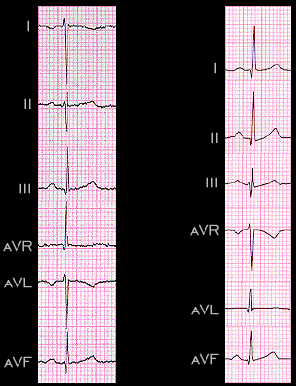
In patients with dextrocardia, the ECG will appear abnormal when recorded with the leads placed in their normal position because the relationship normally present between the leads and the heart will not be present. Reversing the arm leads and placing the precordial leads on the right side of the chest will restore the normal relationship and correct the ECG abnormalities. The six frontal plane leads shown here are from the same patient with dextrocardia that was shown earlier (pages 2.1.30 - 2.1.32). The ECG on the left was recorded with the leads placed in their normal position. It appears as if the arm leads had been reversed. The ECG on the right was recorded after the arm leads were reversed and now appears normal.
